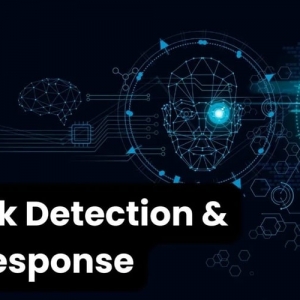Fileless malware has emerged as a formidable threat in today’s cybersecurity landscape. Unlike traditional malware, which relies on files and executables stored on disk, fileless malware operates in-memory and leverages trusted system tools like PowerShell, WMI, or macros in Office documents. Its stealthy, evasive nature makes it extremely difficult to detect using conventional antivirus or signature-based methods.
This is where Extended Detection and Response (XDR) plays a crucial role. By unifying telemetry across endpoints, networks, email, cloud, and identity systems, XDR provides a cohesive view and correlated insights that are essential for detecting and responding to fileless threats.
In this blog, we’ll explore how XDR platforms detect and mitigate fileless malware, and why they are increasingly indispensable for modern cyber defense.
What is Fileless Malware?
Fileless malware is a type of malicious activity that uses legitimate software, scripts, and in-memory execution to compromise systems. It leaves no footprints on disk, making it hard to detect and even harder to investigate. Common tactics include:
-
Exploiting vulnerabilities in applications or browsers
-
Using PowerShell or VBScript to execute code directly in memory
-
Abusing Windows Management Instrumentation (WMI)
-
Using LOLBins (Living off the Land Binaries) like
cmd.exe,rundll32.exe, ormshta.exe
Examples of fileless malware include Emotet, Cobalt Strike, and FIN7 tools, which are often used in APTs and ransomware campaigns.
Why Traditional Security Tools Fail
Fileless malware doesn’t generate traditional Indicators of Compromise (IOCs) like suspicious executable files. As a result:
-
Antivirus/EDR may miss the threat if it only focuses on file-based signatures.
-
SIEM platforms may be overwhelmed with logs and lack context to detect anomalies effectively.
-
Isolated detection mechanisms may see the activity but fail to correlate it across domains (e.g., endpoint, identity, network).
This is why organizations need a more integrated, behavior-driven detection mechanism—enter XDR.
How XDR Detects Fileless Malware
XDR is uniquely positioned to detect fileless threats by leveraging multi-vector telemetry, cross-layer correlation, and AI-driven analytics. Here's how:
1. Behavioral Detection Across Domains
XDR analyzes behavior across:
-
Endpoints: Anomalous PowerShell or WMI usage, parent-child process relationships, in-memory code execution
-
Network: Command-and-control (C2) traffic, data exfiltration over DNS or HTTP
-
Email: Phishing emails with embedded macros or malicious links
-
Identity: Abnormal account behaviors, lateral movement patterns
This holistic visibility allows XDR to detect complex, multi-stage fileless attacks that operate across systems.
2. MITRE ATT&CK Mapping
XDR solutions map activities to MITRE ATT&CK TTPs, helping security teams identify:
-
Initial access (e.g., phishing)
-
Execution (e.g.,
powershell.exewith encoded payload) -
Persistence (e.g., WMI Event Subscriptions)
-
Lateral movement (e.g., remote WMI or PsExec)
-
Exfiltration (e.g., DNS tunneling)
By detecting these TTPs rather than IOCs, XDR effectively uncovers stealthy fileless operations.
3. Correlation and Prioritization
XDR correlates multiple weak signals—such as a user opening a malicious email, followed by a PowerShell command and unusual outbound network activity—into a single high-fidelity alert, reducing alert fatigue and increasing investigation speed.
4. Advanced Analytics and Machine Learning
AI and ML engines within XDR platforms identify anomalies and suspicious behavior by learning normal user and system behavior. For example:
-
A sudden spike in PowerShell activity
-
Abnormal memory usage by a typically benign application
-
Attempts to bypass User Account Control (UAC)
How XDR Mitigates Fileless Malware
Detection is only half the battle. XDR also plays a critical role in containing and responding to fileless threats quickly:
1. Automated Response Playbooks
XDR platforms can trigger automated actions based on detection rules, such as:
-
Isolating infected endpoints from the network
-
Killing malicious processes
-
Disabling compromised user accounts
-
Blocking suspicious IPs or domains
2. Forensic Investigation
Because XDR collects and retains telemetry across domains, it enables thorough post-incident investigations to trace:
-
Initial access vector
-
Techniques used
-
Scope of compromise
-
Lateral movement paths
This aids in understanding the attacker’s behavior and improving defenses.
3. Threat Hunting and Continuous Improvement
With a unified data lake and contextual alerts, XDR empowers threat hunters to proactively look for signs of fileless malware that may have evaded automatic detection.
Advanced queries can look for:
-
Parent-child process anomalies
-
PowerShell with base64 encoded strings
-
Registry modifications without accompanying files
Real-World Example: Fileless Attack Chain
Let’s consider a fileless attack scenario:
-
A user receives a phishing email with an Excel attachment.
-
The attachment contains a macro that spawns
powershell.exeto download and execute a memory-only payload. -
The malware uses
WMIfor persistence and begins lateral movement using stolen credentials. -
Data exfiltration is performed using DNS tunneling.
Traditional tools may miss the threat due to lack of signatures or cross-domain visibility.
XDR can detect it by:
-
Flagging suspicious Excel to PowerShell execution
-
Noticing encoded PowerShell traffic
-
Identifying use of
WMIfor persistence -
Detecting anomalous DNS queries
-
Correlating all of these into a single, prioritized alert
Best Practices for Leveraging XDR Against Fileless Malware
To maximize XDR’s effectiveness:
-
Enable all available telemetry sources: Ensure integration across endpoint, network, identity, cloud, and email.
-
Fine-tune behavioral analytics: Customize detection rules for high-risk assets and privileged users.
-
Use threat intelligence feeds: Augment detections with IOCs related to known fileless malware campaigns.
-
Regularly update response playbooks: Automate responses for known attack patterns.
-
Invest in training for analysts: Equip your SOC team to recognize and respond to fileless threats using XDR consoles.
Conclusion
Fileless malware is one of the most evasive threats facing organizations today. Its ability to operate without leaving a file footprint makes it invisible to many traditional security tools. XDR offers a powerful countermeasure, bringing together telemetry, behavioral analytics, correlation, and automated response in one platform.
By deploying an XDR solution and integrating it deeply into your security operations, you can stay a step ahead of fileless attacks—detecting them early, mitigating their impact, and continuously improving your cyber defense posture.









